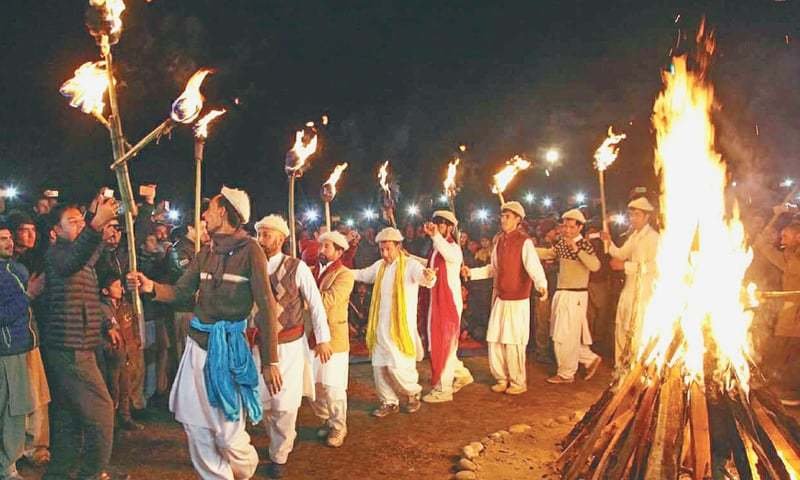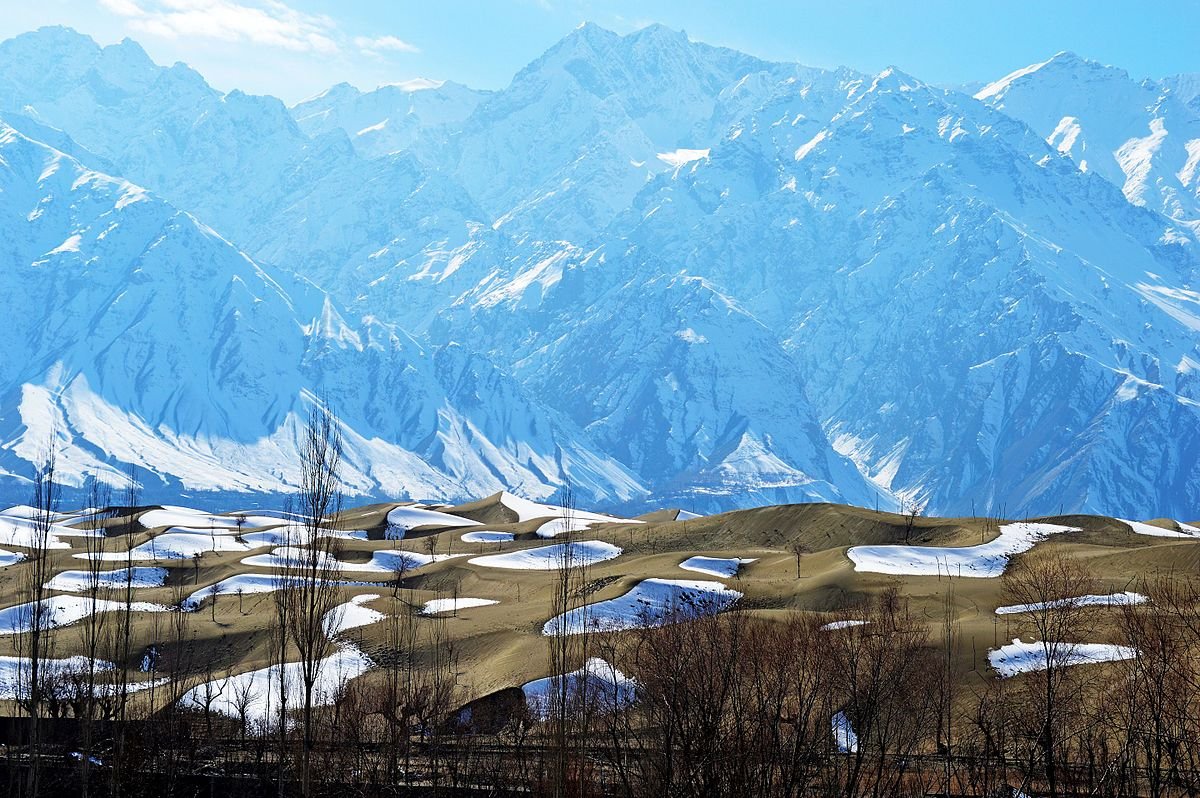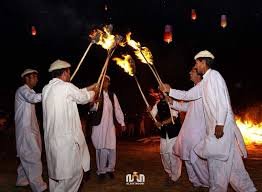By Farman Baltistani

SKARDU: Mayfung, a centuries-old festival is gaining popularity among the people of Baltistan with the passage of time. May Fung, means playing with fire is to welcome the new year and say goodbye to the harsh winter season on December 21 which marks the longest night and shortest day of the year, when the temperature drops to below minus 20 degree celsius.
Symbolically, the mega event is also celebrated to purge society from evil forces.
This year the festival was celebrated on December 21 with a huge fire and dance at New Yadgar-e-Shuhada (monument of martyrs) square.
A beautiful dance was presented by folk artists of Tibet Arts Council on the beat of folk music around a huge bonfire at the square holding burning fire sticks in their hands.
The event was attended by Gilgit-Baltistan’s Senior Minister Haji Akbar Taban, GB council standing committee chairman Ashraf Sada, GB council member Wazir Ikhlaque, and officials.
Baltistan is the cradle of ancient civilization and rich cultural heritage.
The Balti culture is a combination of Bonism and Buddhism. Bonism was a pre-Buddhist shamanistic religion of Tibet, involving worship of spirits and the practice of sacrifice, magic and divination. Before the arrival of Islam in the 14th Century, the people of the whole region from Ladakh to Baltistan, known as ‘Little Tibet’ were followers of Buddhism and Bonism.
Mayfung is a festival of Bonism era which remained in practice during the Buddhist era as well to please their gods so that evils from the society could be cleansed.
Legend has it that by lighting or making a huge fire people set evils on fire. Fortunately, the rising extremism has not affected the festival and the people of Baltistan have kept it alive as an important cultural event said to be a part of Losar festival which is celebrated in Baltistan on 21st December, and in Ladakh, Tibet, Nepal and Bhutan on January 15th each year.
The district administration of Baltistan have started patronising this event for the last few years and celebrate the event comprised of Mayfung and Kopolo officially in each district of Baltistan, which is laudable.
In this festival, people especially young make fire on mountains, plains and the rooftops of houses. Children play and dance holding the burning bunch of logs and wave it in the air, singing special songs related to the festival.
In the end of lighting or Mayfung, people throw the remaining fire in ditches and mountain slopes. In the night, women prepare special dishes at homes and invite relatives and serve fruits as well.
Kopoko is also part of this festival, it is an old traditional game like hockey played by all age of people. ‘Polo’ is a ball and Ko is the distorted shape of kowa which means leather and Kopolo means leather ball.

In older times, people used to pass their harsh winter days by enjoying this game with naturally bended sticks like hockey or mallet. It is totally freestyle and lasts when a team completes 9 goals.
Five things you should know about solstice
December 21 is the winter solstice: the shortest day and longest night of the year.
Starting Friday, the sun will be up for a few seconds longer each day, signaling the start of our slow but steady march towards spring. Learn more about the solstice and why it’s not the coldest day of the year in our scientific guide below.
1. What happens on the winter solstice?
The December solstice marks the exact moment when the sun’s most direct rays reach their southernmost point south of the equator, along the Tropic of Capricorn, at 23.5 degrees south latitude. The time and date of the solstice change slightly each year, but this year’s solstice occurs at 11:28am Eastern Time on Dec. 21.
The reason we have a solstice – and seasons – is because the Earth is tilted on its axis of rotation by about 23.5 degrees. This tilt causes each hemisphere to receive different amounts of sunlight throughout the year as our planet orbits the sun. In the Northern Hemisphere, we see the sun take its lowest and shortest path across the southern sky, and at local noon, your shadow will be the longest of the year.
The word “solstice” comes from the Latin words sol sistere, which means “sun standing still.” On the December solstice, the sun’s daily southward movement in the sky appears to pause, and we see the sun rise and set at its southernmost points on the horizon before reversing direction. It’s a yearly astronomical turning point that humans have celebrated for millennia (just think Stonehenge or the ancient Maya).
2. How many hours of daylight are there on the winter solstice?
The amount of daylight you’ll see on the solstice depends on your latitude, or distance from the equator.
Of course, our long winter night pales in comparison with Alaska, where the sun barely climbs above the horizon for three to four hours in much of the Last Frontier. North of the Arctic Circle – at 66.5 degrees north latitude – the sun never rises, and darkness prevails as the Earth rotates on its axis.
3. When are sunrise and sunset?
The exact times of sunrise and sunset depend on two things: your latitude and geographic location within your time zone.
4. The earliest sunset and latest sunrise don’t occur on the solstice?
The winter solstice marks the shortest daylight period in the Northern Hemisphere. However, it’s never the day of the latest sunrise or earliest sunset. This astronomical quirk happens because of Earth’s 23.5-degree tilt and our elliptical orbit around the sun.
5. Why do the days still get colder after the solstice?
“As the days lengthen, the cold strengthens.” It’s an old proverb that certainly has some scientific truth. The Northern Hemisphere receives its least direct sunlight on the winter solstice, but in many places the coldest average temperatures of winter aren’t until January.
This delay in the arrival of coldest temperatures is better known as seasonal lag. It happens because the amount of solar energy arriving at the ground is less than the amount leaving the earth for a few more weeks (a bit like a bank account that starts losing money when you make more withdrawals than deposits). Oceans and bodies of water – which take longer than land to heat up and cool down – keep temperatures from rising very fast. Not until the Northern Hemisphere sees a net gain in solar energy (more heat coming in than going out) do average temperatures begin their ascent.
The exact timing of the coldest stretch of the year depends on several factors, including how close you live to water, prevailing wind direction and the amount of snow cover (snow is great at reflecting the sun’s heat straight back into space).
If you don’t like the cold, here’s a silver lining: Whatever the rest of winter brings, daylight is once again on the upswing. That’s definitely something to celebrate!

The High Asia Herald is a member of High Asia Media Group — a window to High Asia and Central Asia

